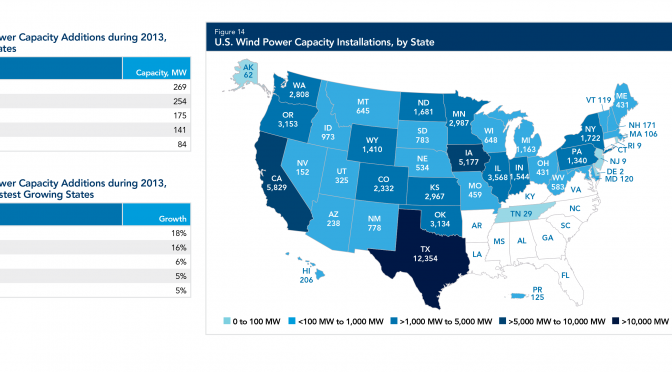The American Wind Energy Association visited Lenexa to showcase the state’s progress as the trade group released its annual U.S. Wind Energy Annual Market Report.
Kansas moved up a notch to No. 8 among states in the amount of installed wind energy capacity and was No. 6 in the total amount of electricity generated by wind in 2013. Only Iowa and South Dakota produced more wind energy than Kansas as a percentage of all electricity generated within their borders.
“It’s really powerful what is happening,” said Elizabeth Salerno, chief economist for the wind association.
A record amount of wind projects are in the works this year nationally, and Kansas wind energy capacity could grow about 25 percent. Wind is now meeting 4.1 percent of the demand for electricity in the U.S., compared with .03 percent a decade ago.
The report comes after a tough year for expansion of wind generating capacity. Just one wind turbine was installed in the U.S. in the first half of 2013 because of uncertainty over whether a popular tax credit would expire at the end of 2012. The incentive got a temporary reprieve, and construction of wind projects picked up by the end of the year, but it was still a down year overall.
In contrast, 2012 was a good year for new projects as developers pushed ahead to be sure to get the tax credits. Kansas doubled its wind generating capacity in 2012.
And last year Kansas’ standing was boosted further with the 250-megawatt Buffalo Dunes Wind Project, developed by TradeWind Energy, which is based in Lenexa. The wind association released its annual report Thursday at TradeWind’s offices.
Kansas has long been regarded as having the country’s second-best wind potential for producing electricity but being slow to develop it. The surge in 2012 and the report Thursday indicate that is beginning to change. The industry also is helped by a state mandate to get a certain percentage of its power from renewable sources.
Randi Tveitaraas Jack, international development manager for the Kansas Department of Commerce, said the job now is to keep the momentum going.
“We want the industry to know that Kansas is wind friendly,” she said.
The state has so far reaped $7 billion in investments for its wind industry, including project developers and a component-making plant in Hutchinson. That has created jobs, and farmers are also getting lease payments for the land where the wind turbines are installed.
“Wind energy has become my most reliable cash crop, even during a drought,” said Pete Ferrell, a cattle rancher in western Kansas who is now associated with a company developing wind energy projects.
Despite the optimism on display Thursday, challenges remain for wind power in Kansas and across the United States.
There are limits to how much more wind energy can be used within Kansas, and more high-capacity transmission lines will be needed to increase the state’s electricity exports.
Rob Freeman, CEO of TradeWind, which has 50 employees, is looking at the promise and challenges ahead for Kansas and the U.S.
His company took a decade to build six wind energy projects and is set to build another six in the next 18 months. Utilities are buying the power, which is competitively priced.
“What coming up for us is unprecedented growth,” he said.
The projects to be built are in Oklahoma, but the company has plans to eventually do more in Kansas.
But Freeman is worried about possible changes in state and federal policies and the “frontal attack on the industry.”
Conservative groups, including the American Legislative Exchange Council, are trying to repeal the renewable energy mandates in Kansas and other states. And the long-term fate of the federal tax credit is cloudy as conservative forces press to phase it out.
“It sends a terrible message to the industry,” he said. “I don’t think Americans are going to stand for that.”


